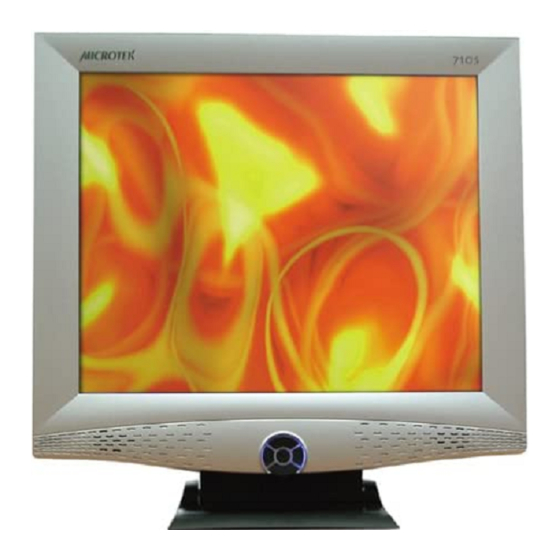
Advertisement
Quick Links
Advertisement

Summary of Contents for Microtek 710S
- Page 1 710S 17” LCD MONITOR USER’S MANUAL...
- Page 2 Table of Contents...
- Page 3 FCC Compliance Statement FCC Warning Caution:...
- Page 4 Radio Frequency Interference Statement Warning: Canadian Doc Notice For Class B Computing Devices...
- Page 5 Important Safety Instructions...
- Page 6 PAY ATTENTION to all Warning and Caution messages. DO NOT use computer components not recommended by the manufacturer. Do not attempt to service the monitor yourself. If a problem occurs, contact the manufacturer’s authorized service center. This monitor is a microprocessor-controlled color monitor that uses a TFT LCD panel.
- Page 7 Table 1 shows standard video mode setting that has been pre-adjusted at the factory for accurate video display. These settings are stored in the monitor’s memory. Table 1. Factory-preset Modes...
- Page 8 Overall Dimensions (H x W x D): Gross / Net Weight Effective Display area (H/V): Wall Mount Display colors: Scan Frequencies: Horizontal Vertical Number of Pixels: Pixel pitch: Picture Tube: Power: Input Consumption Video Connector Audio connector Speaker: RGB Signals: Video Sync Display Data Channel:...
- Page 9 User Controls Control Type: Compatibility: Environmental Limits: Operating Temp. Storage Temp. Operating Humidity Storage Humidity Agency Approval Energy Saving Safety On/Off Power Button Auto-adjustment, Brightness, Menu/Enter and & button On Screen Display, Contrast, Brightness Adjustment, H-position, V-position, Color temperature, Auto Adjustment Digital OSD (On-Screen-Display) IBM and compatibles, Apple Macintosh, NEC...
- Page 10 Before you connect the cables, make sure that the monitor and the system unit power switches are OFF. Plug one end of the 15-pin signal cable to the monitor and the other end to the video signal connector at the rear of the system. Tighten the two screws on the cable connector on both ends.
- Page 11 While pressing on the slider with one hand, use the other hand to bring the LCD panel down until it is on an even level with the VESA mount. Locate the holes for mounting and affix the monitor as desired.
- Page 12 The control functions of the monitor are located on a dial in the lower center portion of the front panel. They are shown in the figure below and described in the following paragraphs. 17” LCD Monitor Description of control keys: : Power Switch &...
- Page 13 : Power switch Use the power switch to turn power ON or OFF. We recommend turning your system power on first before turning on the monitor. & : Up and Down These two keys are used to move the cursor up or down. These two...
- Page 14 The LCD monitor is designed to work with a range of compatible video adapters on the market. Due to the possible deviations between these video adapters, you may need to make some adjustments to fit the monitor for the adapter being used.
- Page 15 We strongly recommend that you use the Auto hot key to get optimized visual quality from your monitor. Pressing the Auto key will perform the adjustment automatically. Use the & key to select the screen similar to the one below will appear.
- Page 16 Use the & key to select the icon, then press the key. A screen similar as below will appear. To go back to the previous OSD menu screen, move to the exit item, then press the key. Use the & key to move to the icon for vertical adjustment or to the icon for horizontal adjustment, then press the key to...
- Page 17 & key to move to the Phase item, then press the key to highlight. Press & to obtain better image quality. Five OSD languages are supported for this monitor, as shown by the screen below. icon , then press key to...
- Page 18 In the OSD screen, you will see the Horizontal frequency (HF), Vertical frequency (VF), display resolution (MODE) and the monitor Firmware version (ROM VERSION). These settings are automatically detected by the monitor, and you will not be able to change them. key to key to...
- Page 19 Monitor. If there is no display on the LCD, please perform the following steps: Make sure that the power indicator on the LCD Monitor is lit, all connections are secure, and the system is running on the correct timing. Refer to table 1 on page 6 for information on timing.
- Page 20 If the PC does not function with the CRT monitor, check the BIOS to see if there is a dual scan setting under the display mode item. Set the BIOS display mode to Dual Scan or CRT and try again. If there is still no display, then there may be a problem with your system.
- Page 21 Pin 1 Pin 2 Pin 1 Pin 2 Pin 3 Pin 4 Pin 5 Pin 6 Pin 7 Pin 8 Pin 9 Pin 10 Pin 11 Pin 12 Pin 13 Pin 14 Pin 15 Ground +12V output Analog Red Input Analog Green Input Analog Blue Input Ground...








